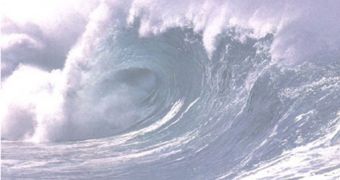The last one has just occurred in the Solomon Islands, taking with it at least 20 victims.
But what's a tsunami?
Tsunami ("harbor wave" in Japanese) represents a series of great sea waves provoked by an underwater earthquake, landslide, or volcanic eruption and sometimes by the collision of a giant meteor with the ocean.
If there is a sufficient force, a violent movement of the earth will induce a sudden displacement of a huge amount of water.
There is not a single wave but a series of waves, named wave train, and the first one is not always the most destructive.
Tsunami waves can be as long as 60 miles (100 km) and can occur as far as one hour apart.
They can pass through entire oceans with minimal energy loss.
The Indian Ocean tsunami went over 3,000 miles (5,000 km) to Africa, with a strength that killed people and damaged property.
In deep water, tsunamis can pass unnoticed even by sailors with surface speeds up to 500 miles (800 km) an hour, traversing an ocean in up to a day, as they can be less than a foot (30 cm) in height.
When the tsunami gets to the shallow water near the shore, it is slowed down and the top of the wave displaces quicker than the bottom, provoking a huge rise of the sea up to 100 ft (30 m), but the average is 10 ft (3 m) and the minim is of a few inches.
The Indian Ocean Tsunami of December 2004 provoked waves as high as 30 feet (9 meters) in some places.
Geological factors like reefs, bays, river entrances, and undersea formations may spread off the tsunami's energy.
The inland can be flooded by over 1000 ft (300 m).
The enormous energy of a tsunami destroys anything in its way: from houses to boats and cars and can transport huge boulders and this can be accompanied by high underwater turbulence, sucking people under and entire beaches can be stripped away.
It is said a tsunami has the sound of a freight train.
The 2004 Indian Ocean tsunami is the most devastating ever; with over 200,000 victims.
The second one could have been a 1782 one, estimated to have inflicted 40,000 victims and was triggered by an earthquake in the South China Sea.
The Pacific is the most active tsunami zone, but they are generated in the Caribbean (37 tsunamis since 1498), Mediterranean Seas, and the Indian and Atlantic Oceans.
The natural warning system of the tsunami is an earthquake.
An earthquake can provoke killer waves thousands of miles across the ocean many hours after it occurs.
A coming tsunami is sometimes preceded by an unusual rapid and strong, visible fall or rise in the water level.
Many people died by the Indian Ocean tsunami as they went down to the beach to look at the exposed seafloor.
The retreating ocean offers people about five minutes' warning to evacuate the zone.
After the first wave, that can be not the strongest, in five minutes to an hour another one will strike.
The cycle can present a repeated retreat and advance of the ocean.
The tsunami waves can go up rivers and streams, so the water runs can prove dangerous, too.
Vessels must not return to port in case of tsunami warning, as these waves inflict changes in water level and dangerous currents in harbors.
People should avoid staying in boats anchored in harbors, as tsunamis can destroy the boats and leave them wrecked in the inland.
The Tsunami Warning System (TWS) in the Pacific employs a network of sensitive recording devices on the seafloor monitoring pressure changes in the overhead water.
The data is transmitted to sensors on buoys, which pass it to satellites for rapid transmission to warning centers. Made of 26 member countries, the system assesses the potentially dangerous earthquakes.

 14 DAY TRIAL //
14 DAY TRIAL //